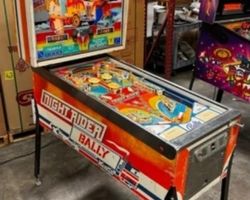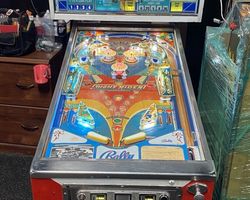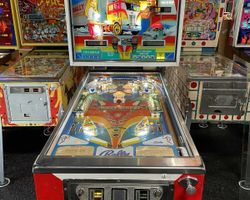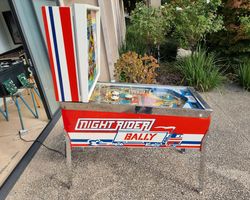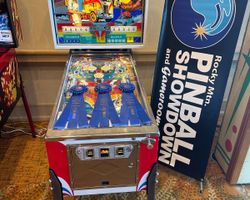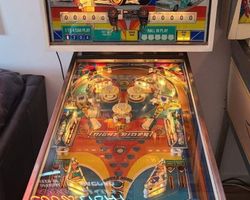Night Rider
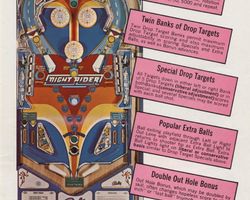
Average Prices: USD $100 to $1,000
Produced: Febuary, 1977
Production Run: 7,000 units
Machine Type: Solid State Electronic
MPU: Bally MPU AS-2518-17
Players: 4
Design by: Greg Kmiec
Art by: Paul Faris
The landscape of pinball machines underwent a significant shift in the late 1970s, transitioning from electromechanical (EM) systems to solid-state (SS) electronics. Bally Manufacturing Corporation stood at the forefront of this evolution, and its 1977 release, Night Rider, serves as a pivotal example of this technological pivot. Produced in February 1977, Night Rider emerged with a production run of 7,000 units, making it a widely distributed game that left a lasting impression. Its theme, deeply rooted in the era's fascination with long-haul trucking, travel, and the open road, captured a specific cultural moment, evoking the atmosphere of roadside diners and the allure of cross-country journeys.
The design of Night Rider was a collaborative effort, featuring the design acumen of Greg Kmiec and the artistic vision of Paul Faris. Kmiec, a designer known for creating engaging and often challenging layouts, brought his signature touch to the playfield. Faris, meanwhile, translated the trucking theme into vibrant, period-appropriate artwork that resonated with players. A particularly noteworthy aspect of Night Rider's production history is its unique position as a bridge between two pinball eras. While Bally had produced an EM version of Night Rider in 1976, the 1977 solid-state model marked a significant technological milestone: it was the first Bally production machine to incorporate the new AS-2518-17 first-generation MPU (Microprocessor Unit). This distinction made the 1977 Night Rider (Model 1074-E) a critical turning point, signaling the industry's move away from physical score reels toward digital LED displays, even though it shared its core design with its EM predecessor. This simultaneous offering of both old and new technology within a single product package presented a distinct choice to operators and players alike, cementing its place in pinball history as a transitionary artifact.
Visual and Auditory Identity
Night Rider establishes its identity through a striking visual and auditory package that immerses players in its 1970s trucking theme. The artwork, a central element of its appeal, is executed with a bold, evocative style. The backglass, in particular, captures the essence of the open road and truck stop culture, depicting imposing big rigs and a welcoming roadside waitress. This imagery is consistently praised for its effectiveness in conveying the classic 70s trucker vibe, serving as an eye-catching focal point. The cabinet art complements the backglass, reinforcing the machine's thematic consistency.
Beyond its visual appeal, Night Rider engages players through its sound design, specifically its chimes. The distinct, pleasing chime sounds are a highlight, contributing significantly to the machine's nostalgic charm and harkening back to the era of electromechanical games. These sounds, along with the clicks and bells accompanying gameplay, create an auditory experience that many players find cool and reminiscent of the 1970s pinball arcade. While the chimes in the solid-state version are occasionally noted as having a slightly different character than their EM counterparts, their overall contribution to the game’s character remains a strong positive, enhancing the overall experience without relying on complex digital sound effects. The blend of new digital scoring with familiar auditory feedback underscored Night Rider's role as a transitional design.
Playfield Engineering
The playfield of Night Rider presents a layout that, while appearing straightforward, contributes to a fast-paced and often challenging gameplay experience. The design philosophy behind the layout centers on accessible targets and a clear shot progression, allowing for an immediate understanding of objectives. The two flippers provide direct control over the ball, launching it into a symmetrical field that encourages precise aiming.
Central to the playfield are its three pop bumpers, positioned to create chaotic, unpredictable ball movement that adds excitement to rallies. Two slingshots on either side of the flippers deflect the ball back into play with force. Scoring opportunities are primarily focused on two five-bank drop target sets, strategically placed for both easy accessibility and a satisfying challenge. These drop targets are often cited as excellent for honing accuracy and building scores. Complementing these are three standup targets and two spinning targets. The spinners, in particular, are rewarding when hit squarely, generating a rapid succession of points and a pleasing sound.
A single kick-out hole, or saucer, is located at the top of the playfield. This feature, common in Greg Kmiec's designs, collects the ball and awards points or advances game features, providing a moment of respite before the ball is returned to play. The overall layout, though sometimes described as simple or with elements pushed to the edges, maintains a brisk flow. The arrangement of targets and the pathways for the ball ensure that action is almost continuous. The artwork on the playfield integrates seamlessly with the overall theme, featuring graphic elements related to trucks and travel that guide the player’s eye to key scoring areas, ensuring visual cohesion with the distinctive backglass and cabinet art.
Engaging Gameplay
Night Rider's gameplay dynamics are characterized by their immediate accessibility, coupled with a deceptive layer of challenge. The rules are simple and intuitive, making it easy for new players to grasp the core objectives within minutes. The primary goal often revolves around clearing the sets of drop targets and activating the spinning targets to accumulate points. The strategic aim is to build and collect the double bonus, which becomes a crucial element for achieving high scores. This straightforward scoring mechanism provides clear feedback and a tangible objective for players.
Despite its apparent simplicity, Night Rider possesses a demanding nature. The fast pace of the game, combined with the layout of its outlanes and the positioning of certain shots, frequently leads to quick drains. For instance, the central advance bonus button target, while seemingly a direct shot, can prove to be a "death shot" if not handled with precision, leading to a swift loss of the ball. This inherent difficulty ensures that skillful ball control, precise flipper work, and an understanding of the playfield's nuances are essential for extended play and high scores. Players quickly learn the importance of clean shots to the drop targets and powerful spinner hits to maximize their points. The game does not feature complex multi-ball modes or intricate wizard goals, but instead focuses on the fundamental challenge of keeping the ball in play and hitting targets effectively under pressure. This approach fosters an addictive "one more game" mentality, as players strive to improve their score and conquer the inherent difficulty of the layout.
Enduring Reputation
Night Rider holds a well-defined position in the pinball community, largely regarded as a classic from its era. The overall sentiment is predominantly positive, with players frequently praising it as a fun, engaging, and addictive machine that encapsulates the essence of 1970s pinball design. Its strengths are numerous: the strong nostalgic 70s theme, particularly the acclaimed backglass and cabinet art, resonates deeply with enthusiasts. The distinctive chime sounds are consistently highlighted as a major positive, contributing to its authentic period feel. Gameplay is lauded for its brisk pace and the rewarding satisfaction of clearing drop targets and hitting the spinners. Many players appreciate its deceptive challenge; while the rules are simple, the game demands skill and precise ball control, often leading to swift drains for the unwary.
However, Night Rider is not without its points of contention. Some players find its straightforward rules and relatively simple playfield layout to lack the depth required for long-term engagement, suggesting it can become repetitive for those accustomed to more complex modern machines. The symmetrical and somewhat "pushed to the edges" layout is occasionally cited as less imaginative than other designs. The perceived underutilization of the central advance bonus target is another minor critique, with some feeling it could have hosted a more dynamic feature. Furthermore, while the solid-state version was a technological leap, some observers note that its gameplay feels remarkably similar to its electromechanical predecessor, leading to discussions about the true impact of the new MPU on this particular design. Despite these minor criticisms, Night Rider's legacy as a pivotal transition machine remains undisputed. It signaled the definitive shift to digital scoring and the adoption of solid-state electronics as the new standard for Bally, paving the way for countless future designs. Its enduring appeal lies in its combination of accessible gameplay, period-defining aesthetics, and its historical significance as one of the very first machines to bring digital displays into widespread use in the pinball arcade.
Sponsored Links
 Ebay Listings
Ebay Listings
 Auction Results
Auction Results
| Cost | Location | Date |
|---|---|---|
| USD $700 |  California, United States California, United States |
24 August, 2025 |
| USD $2,499 |  Texas, United States Texas, United States |
23 March, 2025 |
| USD $5,999 |  Colorado, United States Colorado, United States |
30 October, 2023 |
| USD $4,795 |  Canada Canada |
01 February, 2023 |
| USD $2,499 |  Florida, United States Florida, United States |
05 August, 2022 |
| AUD $4,400 |  Victoria, Australia Victoria, Australia |
12 April, 2022 |
| USD $2,489 |  Florida, United States Florida, United States |
23 March, 2022 |
| USD $800 |  Pennsylvania, United States Pennsylvania, United States |
20 November, 2021 |
| USD $2,395 |  Ohio, United States Ohio, United States |
12 October, 2021 |
| USD $1,436 |  California, United States California, United States |
12 May, 2021 |


Private Policy · Search Website · Contact Us
As an eBay Partner, we may earn a commission from qualifying purchases made through links on this site, at no additional cost to you.
All trademarks and copyrighted materials remain property of their respective owners. All other content copyright 2007 - 2025 Pinpedia.

